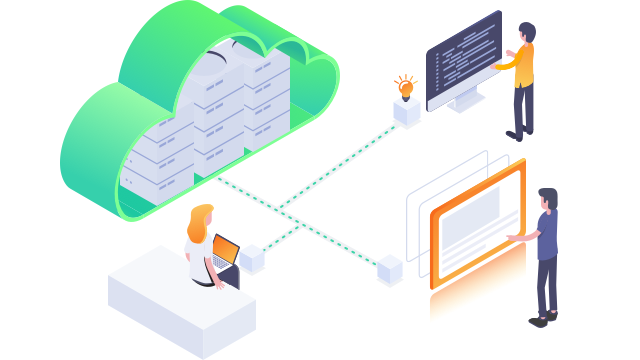Accelerate AI Innovation with Enterprise GPU Power and AI Studio
Bitdeer AI Cloud delivers secure, scalable GPU servers and an intuitive AI Studio platform to streamline AI and ML workflows. As an NVIDIA Preferred Partner, we provide top-tier compute power, real-time collaboration, scalable training, seamless model management, and secure storage—empowering faster, smarter innovation.

SEALMINER
Bitdeer's self-developed mining machine that harnesses the advanced SEAL series chip for exceptional efficiency, featuring a brand-new design architecture that maximizes chip potential, ensuring reliability, durability, and optimal performance even in harsh environments.
Resources
Navigate through our resource hub to find what you need. Subscribe to keep up-to-date with our latest news, announcements and blog posts.
Subscribe to our newsletter

Bitcoin Mining Efficiency: The Road From 5,000,000 to 5 J/TH (And Beyond)
Aug 19 2024
Over the past 15 years, the mining industry has achieved remarkable strides in hardware efficiency. Since the early days of CPU mining in 2009, when Satoshi Nakamoto used a personal computer to mine the Genesis block, the sector has seen dramatic evolution through multiple generations of specialized hardware and innovations like immersion cooling.
At Bitdeer, we are committed to driving transparency and innovation in the industry. As part of this commitment, our advanced chip design will enable SEALMINER to triple the energy efficiency of ASIC miners by the second half of 2025. Furthermore, as we continue to refine chip design techniques, we anticipate further breakthroughs that could benefit multiple industries, including HPC and AI.
Below is the summary of the keynote speech presented by Bitdeer’s Chief Strategy Officer Haris Basit at the Bitcoin 2024 2024 conference. The full transcript is available via this link.
Bitcoin Mining’s Efficiency: How it Started
In the first five years of Bitcoin mining, from 2009 to 2013, equipment energy efficiency skyrocketed by 5000x. We transitioned from CPUs, consuming about 5,000,000 Joules per terahash (J/TH), to GPUs, then to FPGAs, and ultimately to ASICs designed specifically to maximize Bitcoin extraction. This evolution, largely driven by Bitcoin’s halving design that slashes block rewards in half every four years, marked a significant leap in mining efficiency and technology.
From Bitdeer CSO Haris Basit's presentation at Bitcoin 2024.
The ASIC Era: Pushing the Limits
Since the ASIC era began in 2013, there has been an additional 1000x improvement in efficiency. We started with 110nm silicon processes, and today, we are utilizing cutting-edge 4nm technology, with 3nm developments on the horizon. Each progression in silicon manufacturing has brought significant efficiency enhancements. For instance, the introduction of full-custom designs during the 28nm process period led to major efficiency gains without requiring changes to the underlying manufacturing technology.
From Bitdeer CSO Haris Basit's presentation at Bitcoin 2024 in Nashville
Current Trends and Innovations
Recent years have shown that efficiency improvements in mining hardware have significantly slowed down. Despite this, Bitdeer’s R&D department is breaking new ground. Our SEALMINER roadmap outlines plans to introduce new chip designs nearly every other quarter, continuously setting new benchmarks for energy efficiency in the industry.
By the second half of 2025, we aim to release mining rigs with energy efficiencies at or below 5 J/TH—three times more efficient than the best rigs available today. This ambitious goal hinges not just on advancements in manufacturing but also on innovative chip design.
From Bitdeer CSO Haris Basit's presentation at Bitcoin 2024 in Nashville
The Future of Chip Design
Bitcoin mining uses the SHA256 digital function, traditionally optimized through digital design processes. However, these methods lack the energy efficiency needed for Bitcoin mining, prompting the shift to analog design techniques over the past nine years. This approach, known as full-custom design, requires working at the transistor level with voltages and currents instead of at the logical level with zeros and ones but is crucial for achieving necessary energy efficiency.
Looking forward, we're exploring advanced techniques beyond analog design, drawing from radio frequency (RF) and microwave design including distributed circuit design. These methods involve fully hand-crafted circuits, demanding even more skill than analog chips, and require a deep understanding of electromagnetic waves. Despite its complexity, this approach promises significant efficiency breakthroughs.
More specifically, as we seek to enhance Bitcoin mining efficiency in the future, we are focusing on improving two main types of power consumption:
- Switching Power
Switching power is the energy used when the chip’s transistors turn on and off, which happens constantly. Each time a transistor changes state, new charge is pulled in from the power supply, or excess charge is flushed away without being reused.
The total amount of charge in the chip stays about the same, with roughly 50% being "on" at any time, but we don’t recycle this charge—instead, we always bring in a new charge. This is why electronics' energy efficiency, including Bitcoin mining, has been limited by the same principle since the early 1970s.
Recycling charge, by moving it where it's needed instead of pulling in new charge, would be a massive breakthrough.
- Leakage Power
Leakage happens when electrons pass through barriers that should block them in a classical physics approach. Leakage is an effect explained by quantum physics. Especially as transistor gates get narrower they are governed much more by this quantum effect. This power loss gets worse with higher temperatures, which is why ASICs get less efficient as they heat up, and one reason why using liquid cooling technology is being increasingly adopted by the industry.
Foundries have been tackling leakage power by using FinFET technology and will soon use RibbonFET or Gate All Around technology. However, using distributed design and charge recycling methods can also greatly cut down on this power loss, reducing our reliance on new manufacturing technologies.
Pioneering the Future
Bitdeer is leading the way in these innovations. Our work not only sets new standards for efficiency in Bitcoin mining but also holds promise for broader applications. As we refine chip design techniques, these improvements could also enhance AI and high-performance computing (HPC) chips, potentially leading to major energy savings across multiple industries.
Looking ahead, Bitdeer’s advances may open the door to developments that bring net negative energy consumption in Bitcoin mining closer to reality.
*Information provided in this article is for general information and reference only and does not constitute nor is intended to be construed as any advertisement, professional advice, offer, solicitation, or recommendation to deal in any product. No guarantee, representation, warranty or undertaking, express or implied, is made as to the fairness, accuracy, timeliness, completeness or correctness of any information, or the future returns, performance or outcome of any product. Bitdeer expressly excludes any and all liability (to the extent permitted by applicable law) in respect of the information provided in this article, and in no event shall Bitdeer be liable to any person for any losses incurred or damages suffered as a result of any reliance on any information in this article.







